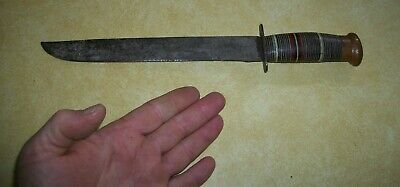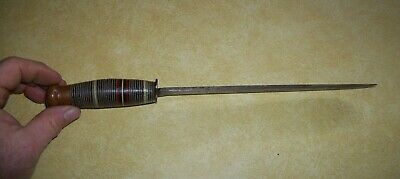-40%
VTG TRENCH KNIFE VIETNAM WAR THEATER MADE LONG BLADE FIELD GEAR ARMY PERSONNEL
$ 78.67
- Description
- Size Guide
Description
VTG TRENCH KNIFE VIETNAM WAR THEATER MADE LONG BLADE FIELD GEAR ARMY PERSONNELVTG TRENCH KNIFE VIETNAM WAR THEATER MADE LONG BLADE FIELD GEAR ARMY PERSONNEL
VTG TRENCH KNIFE VIETNAM WAR THEATER
MADE LONG BLADE
FIELD GEAR ARMY PERSONNEL
Click image to enlarge
Description
GREETINGS, FEEL FREE
TO
"SHOP NAKED."
©
We deal in items we believe others will enjoy and want to purchase.
We are not experts.
We welcome any comments, questions, or concerns.
WE ARE TARGETING A GLOBAL MARKET PLACE.
Thanks in advance for your patronage.
Please Be sure to add WDG to your
favorites list
!
NOW FOR YOUR VIEWING PLEASURE…
OOAK / ONE OF A KIND
TRENCH ART / TRENCH KNIFE
CREATED IN COUNTRY
BY LOCAL ARMY PERSONNEL
SGT. MAJOR
VIETNAM ERA
MEASURES ABOUT 13"
STACKED HANDLE
ASSORTED MATERIAL
BRASS / BRONZE POMMEL
LONG BLADE
---------------------
FYI
Militaria are artifacts or replicas of military, police, etc., collected for their historical significance. Such antiques include firearms, swords, knives, and other equipment such as; uniforms, helmets, other military headgear, and armour; military orders and decorations; challenge coins and awards; badges, buttons and insignia; military art, sculpture, and prints; ephemera such as cigarette cards, photographs, antiquarian books, magazines and posters; scale models and toy soldiers; and items of combat equipment and field gear.
Today, the collecting of militaria is an established hobby among many groups of people. Many European families, specifically those royal families with long martial tradition, have large collections of militaria passed down from generation to generation. Also, many people today collect militaria for investment purposes.
An alternate name, used by many dealers, for militaria is 'military antiquities' or 'military antiques'.
-----------------------
The Vietnam War (Vietnamese: Chi?n tranh Vi?t Nam, in Vietnam also known as the American War, Vietnamese: Chi?n tranh M?), also known as the Second Indochina War, was a Cold War-era proxy war that occurred in Vietnam, Laos, and Cambodia from December 1956 to the fall of Saigon on 30 April 1975. This war followed the First Indochina War and was fought between North Vietnam—supported by the Soviet Union, China and other communist allies—and the government of South Vietnam—supported by the United States and other anti-communist countries. The Viet Cong (also known as the National Liberation Front, or NLF), a lightly armed South Vietnamese communist common front directed by the North, fought a guerrilla war against anti-communist forces in the region. The People's Army of Vietnam (a.k.a. the North Vietnamese Army) engaged in a more conventional war, at times committing large units into battle. As the war wore on, the part of the Viet Cong in the fighting decreased as the role of the NVA grew. U.S. and South Vietnamese forces relied on air superiority and overwhelming firepower to conduct search and destroy operations, involving ground forces, artillery, and airstrikes. In the course of the war, the U.S. conducted a large-scale strategic bombing campaign against North Vietnam, and over time the North Vietnamese airspace became the most heavily defended airspace of any in the world.
The U.S. viewed American involvement in the war as a way to prevent a Communist takeover of South Vietnam. This was part of a wider strategy of containment, which aimed at stopping the spread of communism. According to the U.S. domino theory, if one state went Communist, other states in the region would follow, and U.S. policy thus held that accommodation to the spread of Communist rule across all of Vietnam was unacceptable. The North Vietnamese government and the Viet Cong were fighting to reunify Vietnam under communist rule. They viewed the conflict as a colonial war, fought initially against forces from France and then America, as France was backed by the U.S., and later against South Vietnam, which it regarded as a U.S. puppet state. Beginning in 1950, American military advisors arrived in what was then French Indochina. U.S. involvement escalated in the early 1960s, with troop levels tripling in 1961 and again in 1962. U.S. involvement escalated further following the 1964 Gulf of Tonkin incident, in which a U.S. destroyer clashed with North Vietnamese fast attack craft, which was followed by the Gulf of Tonkin Resolution, which gave the U.S. president authorization to increase U.S. military presence. Regular U.S. combat units were deployed beginning in 1965. Operations crossed international borders: bordering areas of Laos and Cambodia were heavily bombed by U.S. forces as American involvement in the war peaked in 1968, the same year that the Communist side launched the Tet Offensive. The Tet Offensive failed in its goal of overthrowing the South Vietnamese government but became the turning point in the war, as it showed that South Vietnam was unable to fend for itself against the North, despite many years of massive U.S. military aid. As the point of U.S. victory was indeterminate, U.S. ground forces were gradually withdrawn as part of a policy known as Vietnamization, which aimed to end American involvement in the war while transferring the task of fighting the Communists to the South Vietnamese themselves. Despite the Paris Peace Accords, which was signed by all parties in January 1973, the fighting continued.
In the U.S. and the Western world, a large anti-Vietnam War movement developed. This movement was both part of a larger Counterculture of the 1960s and also fed into it.
Direct U.S. military involvement ended on 15 August 1973 as a result of the Case–Church Amendment passed by the U.S. Congress. The capture of Saigon at the hands of the North Vietnamese Army in April 1975 marked the end of the war, and North and South Vietnam were reunified the following year. The war exacted a huge human cost in terms of fatalities (see Vietnam War casualties). Estimates of the number of Vietnamese service members and civilians killed vary from 800,000 to 3.1 million. Some 200,000–300,000 Cambodians, 20,000–200,000 Laotians,and 58,220 U.S. service members also died in the conflict.
(THIS PICTURE FOR DISPLAY ONLY)
---------------------------
Thanks for choosing this auction. You may email for alternate payment arrangements. We combine shipping. Please pay promptly after the auction. The item will be shipped upon receipt of funds. WE ARE GOING GREEN, SO WE DO SOMETIMES USE CLEAN RECYCLED MATERIALS TO SHIP.
Please leave feedback when you have received the item and are satisfied. Please respond when you have received the item.
*****
5*'s
*****
If you were pleased with this transaction, please respond with all 5 stars! If you are not pleased, let us know via e-mail. Our goal is for 5-star service. We want you to be a satisfied, return customer.
Please express any concerns or questions. More pictures are available upon request. The winning bid will incur the cost of S/H INSURED FEDEX OR USPS. See rate calculator or email FOR ESTIMATE. International Bidders are Welcome but be mindful if your country is excluded from safe shipping.
Thanks for perusing
THIS
and
ALL
our auctions.
Please Check out our
other items
!
WE like the curious and odd.
BUY, BYE!!
Images sell!
Get Supersized Images & Free Image Hosting
Create your brand with Auctiva's
Customizable Templates.
Attention Sellers - Get Templates
Image Hosting, Scheduling at Auctiva.com.
Track Page Views With
Auctiva's FREE Counter














